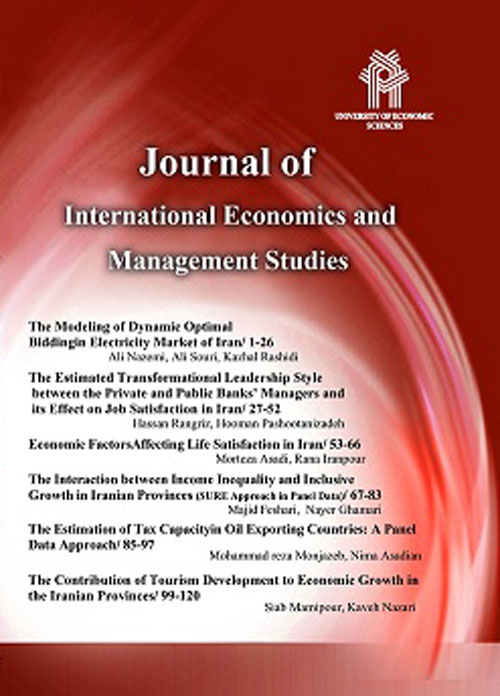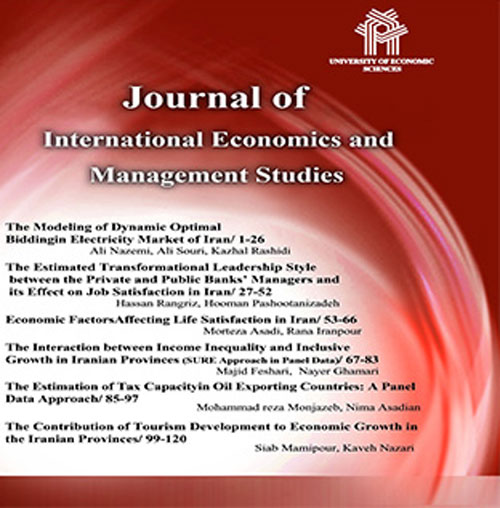فهرست مطالب

International Journal of Economics and Management Studies
Volume:1 Issue: 1, 2015
- تاریخ انتشار: 1394/10/10
- تعداد عناوین: 6
-
Pages 1-26The main goal of this paper is to modeling of producers strategic suggestions for each electricity manufacturer in an oligopolistic structure. According to the proposed structure of the electricity market modeling; this paper uses a dynamic model based on cournot equilibrium. Due to the large volume of required information, the implementation of the model is limited to a regional electricity market and the model is be implemented in such as a way to compare the results for low, medium and peak load consumption. Market actors in the research are active power plants in Isfahan electricity region and MATLAB software has been used for solving the model. The empirical results of model with the actual behavior of actors in selected hours have been compared and finally by comparing the actual behavior of actors with the results of the simulation model, the analysis and results are presented. Accordingly it is clear that the producers did not use cournot strategy. Although the proposed strategy can be more profitable for them.Keywords: Electricity Market, Cournot Equilibrium, Bidding
-
Pages 27-52The main objective of this paper is to investigate the Leadership style between Public and Private Bank and its impact on the job satisfaction in Iran. For this purpose, the relationship between transformation and transactional leadership and job satisfaction and the effect of managers decision-making strategy and employees job perception on it have been considered empirically. The overall findings of this research indicate that there is no significant difference between employees job satisfaction who works in Command and Queue unit in state-owned Iranian banks, but there is significant difference between employee's job satisfaction who works in Command and Queue unit in Iranian private banks.In addition, there is no significant difference in transformational leadership style between private and public Iranian banks.Keywords: Transformational Leadership, Transactional Leadership, Job Satisfaction, Occupation Perception
-
Pages 53-66The subject of the life satisfaction is one of the important issues in development economics literature. In this paper, the main determinants of life satisfaction such as economic factors have been considered. For data analysis, the indices of life satisfaction have been collected among 400 people in Tehran and neibouring provinces by applying stratified random sampling method. Then, data field method and questionnaire have been used for data analysis. The empirical results of this paper reveal that GDP and HDI index have positive and other explanatory variables such as income inequality, population growth have positive and negative significant impact on the life satisfaction in Iran respectively.Keywords: Life Satisfaction, Economic Indices, Welfare, productivity, human's subjective Indices, Government Policy
-
Pages 67-83The concept of inclusive growth is one of the important issues in the urban economics literature and has been considered in empirical studies recently. For this purpose, the main aim of this paper is to investigate the relationship between income inequality and GDP growth in Iranian provinces over the period of 2000-2012. To conduct this study, the econometric model has been estimated by applying seemingly unrelated regression in panel data for 30 Iranian provinces.
The empirical findings of this paper shows that the Gini coefficient as a proxy for income inequality and unemployment rate have negative and the initial level of Gini coefficient has positive and significant effect on the growth of GDP respectively. The overall conclusion of this study suggests that inequality of Iranian provinces can be decreased by improving employment and growth of per capita incomeKeywords: Inclusive Growth, Income Inequality, Growth of GDP, SURE Approach in Panel Data -
Pages 85-97The tax capacity is one of the main concepts in public finance and provides the required information on state economic power in mobilizing the tax resources for responding the financial problems and execution of economic policies. For this purpose, the main objective of this paper is to estimate the tax capacity for oil exporting countries over the period of 1995-2008 by applying panel data approach. The summary of results indicates that the GDP per capita and trade openness are the main factors affecting the ratio of tax revenue to GDP. Also, the empirical findings of this study reveal that countries with a low share of oil exports have more Potential tax capacities. Moreover, the potential tax capacity of Iran is the same as its actual tax during the period of study.Keywords: Tax Capacity, Oil Exporting Countries, Panel Data Approach
-
Pages 99-120The main objective of this paper is to estimate the tourism impact on the economic growth of Iranian provinces over the period of 2000-2010. For achieving this aim, the panel data approach has been used to the economic growth modeling. The empirical findings show that tourist receipts have a positive impact on the economic growth in Iranian provinces. It was found that a 10 percent increase in the spending of tourists leads to a 1 percent increase in the GDP per capita. In addition, physical and human capital has positive effects on economic growth, while unemployment rate and consumer price index have negative effect on the economic growth. Finally, the results of this study indicate that the product elasticities are inelastic in Iran during the period of 2000-2010.Keywords: Tourism Revenues, Economic Growth, Iranian Provinces, Panel Data Approach


